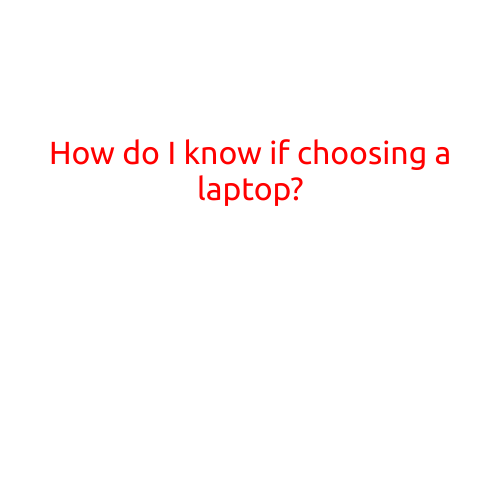
What Should I Do if Choosing a Laptop?
Choosing a laptop can be a daunting task, especially with the numerous options available in the market. With so many features, specifications, and prices to consider, it’s easy to get overwhelmed and make the wrong choice. In this article, we’ll guide you through the process of selecting the perfect laptop for your needs and budget.
Step 1: Determine Your Needs
Before you start shopping for a laptop, take some time to think about how you plan to use it. Will you be using it primarily for work, school, or personal use? Do you need it for gaming, video editing, or general web browsing?
Consider the following questions:
- Do you need to stay productive on-the-go?
- Do you need to work with large files and software?
- Do you prefer a lightweight and portable laptop or a more powerful one?
- Do you have a budget in mind?
Answering these questions will help you narrow down your options and focus on the features that matter most to you.
Step 2: Set a Budget
Laptops can range in price from a few hundred to several thousand dollars. Set a budget before you start shopping to ensure you don’t overspend.
Consider the following:
- Basic laptops with minimal features can start at around $200.
- Mid-range laptops with decent processors and memory can cost between \(500 and \)1,000.
- High-end laptops with advanced processors, memory, and features can cost $1,500 or more.
Step 3: Consider Key Features
Once you have a budget in mind, it’s time to think about the key features you need. Here are some to consider:
- Processor: A faster processor (CPU) will handle demanding tasks more efficiently. Look for processors from Intel Core (i3, i5, i7) or AMD Ryzen (3, 5, 7).
- Memory (RAM): A minimum of 8GB RAM is recommended, but 16GB or more is ideal for heavy users.
- Storage: Solid-state drives (SSDs) are faster and more reliable than traditional hard disk drives (HDDs). Aim for at least 256GB of storage.
- Display: A higher resolution (Full HD or 4K) and a larger screen size (13-15 inches) provide better visuals.
- Graphics: Integrated graphics are suitable for general use, while dedicated graphics are necessary for gaming and video editing.
Step 4: Research and Compare
Research different laptops and compare their features, specs, and reviews. You can:
- Read online reviews from reputable sources like CNET, Laptop Mag, and Wired.
- Check out comparison charts and guides from websites like PCMag and Tom’s Guide.
- Ask friends, family, or colleagues for recommendations.
Step 5: Check for Durability and Support
A laptop’s durability and support are just as important as its features. Consider:
- Build quality: A sturdy and well-built laptop will withstand daily use.
- Warranty: Look for laptops with a good warranty and reliable customer support.
- Software updates: Ensure that the laptop manufacturer provides regular software updates and security patches.
Conclusion
Choosing the right laptop requires careful consideration of your needs, budget, and features. By following these steps, you’ll be well-equipped to find the perfect laptop for your lifestyle. Remember to prioritize your needs, set a budget, and research thoroughly to ensure you make an informed decision.
Happy shopping!





